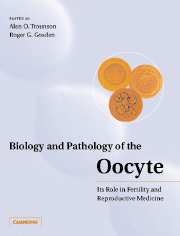Book contents
- Frontmatter
- Contents
- List of contributors
- Preface
- Part I Historical perspective
- Part II Life cycle
- Part III Developmental biology
- Part IV Pathology
- Part V Technology and clinical medicine
- 17 Growth and development of the mammalian oocyte-granulosa cell complex in culture
- 18 Human oocyte maturation in vitro
- 19 Follicular factors affecting oocyte maturation and developmental competence
- 20 Low temperature storage of follicular and ovulated oocytes
- 21 Fecundity of transplanted ovaries
- Index
18 - Human oocyte maturation in vitro
from Part V - Technology and clinical medicine
Published online by Cambridge University Press: 05 August 2016
- Frontmatter
- Contents
- List of contributors
- Preface
- Part I Historical perspective
- Part II Life cycle
- Part III Developmental biology
- Part IV Pathology
- Part V Technology and clinical medicine
- 17 Growth and development of the mammalian oocyte-granulosa cell complex in culture
- 18 Human oocyte maturation in vitro
- 19 Follicular factors affecting oocyte maturation and developmental competence
- 20 Low temperature storage of follicular and ovulated oocytes
- 21 Fecundity of transplanted ovaries
- Index
Summary
Introduction
Human oocytes will spontaneously complete nuclear maturation when released from antral follicles and cultured in vitro for 24-48 hours (Edwards, 1965). Germinal vesicle breakdown (GVBD) can be observed to occur after 12 hours but this is not synchronous and, in some oocytes, GVBD does not begin until 24 hours after the beginning of culture (Trounson et al., 1994; Cha and Chian, 1998). The onset of GVBD occurs on average 9 hours earlier in vitro if the women have been given an ovulating dose of human chorionic gonadotropin (hCG) 36-40 hours before oocyte recovery. Completion of nuclear maturation (metaphase II (Mil) of meiosis) in vitro is observed between 24 and 48 hours of culture for untreated patients but is complete within 30 hours in patients given hCG. The difference between hCG-treated and nontreated patients is that maturation is initiated in vivo in hCG-treated women, with 40% or more oocytes showing GVBD at oocyte recovery (Chian et al., 2000).
The ability to resume meiosis after liberation from the follicle is partly dependent on oocyte diameter and increases significantly as the oocytes increase from 90 to 120 µm (Durinzi et al., 1995). Blastocysts can be produced from follicles of at least 6 mm diameter when women are given hCG and their oocytes recovered 36 hours later for in vitro maturation (IVM) and in vitro fertilization (IVF) (Figure 18.1) (Trounson et al., 2001). Wynn et al. (1998) reported that a 5 mm diameter was the minimum size from which oocytes will mature in vitro, but the evidence from patients with the polycystic ovarian syndrome (PCOS) phenotype is that oocytes from antral follicles of even 2-3 mm can mature in vitro (Trounson et al., 1994). This could be due to interrupted follicle growth in PCOS patients where the predominance of follicles are in atresia and the oocyte begins to lose the tightly adherent corona radiata cells that usually surround it (Barnes et al., 1996). The corona cells maintain contact with the oocytes by long transzonal processes (see Chapter 13) that enable follicle cells to maintain the inhibition of GVBD. These processes are withdrawn during atresia and may initiate GVBD and nuclear maturation when oocytes are liberated from the follicular environment, even in small antral follicles of 2-3 mm diameter.
- Type
- Chapter
- Information
- Biology and Pathology of the OocyteIts Role in Fertility and Reproductive Medicine, pp. 283 - 304Publisher: Cambridge University PressPrint publication year: 2003
- 1
- Cited by



